The Canon A-1 can
be regarded as both a simple and complex SLR camera. In a way, it comes close to
satisfy many levels of photographers. This compact SLR camera can be set to operate
six different ways with FD lenses, where five of them using automatic exposures!
It can be a very friendly camera (provided you don't simply alter the other settings)
because one of the automatic modes, called Programmed Automatic Exposure (AE) sets
both the shutter speeds and aperture size for you automatically. All you have to
do is focus - in a way, some
will find it easier to master the camera compared to the shutter priority and manual
over-ride Canon AE-1.
 |
If you still complaint that you have to wind the film manually, add a motor drive or one of the two power winders and it will handle and advances the film automatically for you. There's nothing left to do except operate the shutter button. It's also complex because of all the different ways it can be operated and the variety of control settings you need to make and select the various modes of operations.Unlike cameras around its time, the A-1 can be regarded as an amazing leap forward in camera technology, and representing the best of commercial applications of digital technologies in a consumer product during the mid-seventies. To mention the Canon A-1, it is difficult if the unique AT Dial's functions and its operations are not being addressed first. Generally, the setting of shutter speeds is done by means of the shutter-speed dial located on top of a camera - but the Canon A-1 has no such dial atop its body as compared with other SLR cameras! |
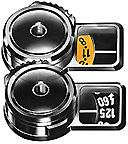 |
Prior to the birth of the A-1, most cameras were set up to be operated in that conventional manner. One of the most unusual things about the A-1 when compared with SLRs of other makes is its lack of a shutter-speed dial on the top plate of the camera! |
The dial is instead located partly underneath the camera's top plate via the afore-mentioned AT-Dial. The next amazing thing is: Once the lens is set on "A" (Auto). the aperture ring on the lens doesn't have to be moved at all because you can operate and change the aperture value using virtually the same AT-Dial. As I have said earlier, the Canon A-1 has some very original ideas of its own, you can say they are revolutionary because they changes the way how a photographer operates a camera.
 |
|
With the advantage of the equally
unique FD-mount, Canon eliminates the necessity of moving the aperture ring on the
lens. Instead, they devised two controls, both located within easy reach of the photographer's
right thumb and index finger for single hand operation. For any mode, the first step is to turn
the Main Switch from 'L' to 'A'. The next
choice is AE - which stands for 'automatic exposure'(Set the ring to
the green A or O and the camera is on automatic) or non-automatic
(Turn the ring away from A, to any f-number setting, and the camera is not on automatic).
Only an FD lens that is mounted directly on the camera, or with meter-coupled accessories
between lens and camera, can be set for automatic operation.
Then you choose
one of two settings of the Mode Switch. Exposure Value (EV) is the combination
of Aperture value (Av) and Time value (Tv). The Mode Switch has two
settings: Av and Tv. When you move the Mode Switch, a mask will move
to the left or right in the small mode display window. If you select AE mode to Av
(with yellow 'O'), the mask moves to show
you a scale of aperture numbers. Use the AT Dial to select aperture. If you select
Tv, the display window will show a scale of shutter speeds. You can thus use
the AT Dial to select a shutter speed. Whwn your AE preference is on Programmed AE
mode. The setting for this mode is the green symbol 'P',
which is on the shutter-speed scale, just past 1000. When you have the Mode Selector
set to Tv, use the AT Dial to select 'P' if you preference is on
Programmed AE.
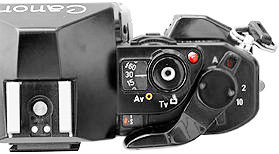 |
If you select Av, you control aperture; the camera will set shutter speed for correct exposure of an average scene. If you select Tv with the camera on automatic, you set shutter speed and the camera sets aperture size automatically. These two input settingd are used for exposure control in the A-1. |
The AE mode selector is
ring around the shutter release button which is knurled just right for a thumb to
operate quickly. The words "Av" and "Tv" signifies
'Aperture Value' and 'Time Value' respectively, with a yellow circle and white rectangle
respectively in the top right-hand corner. This Av indicating Aperture Priority
and Tv being Shutter-Priority AE.
The yellow circle O
and rectangle serve as further reminder of the mode you are active working with,
their colors corresponding to that of their dial settings. When you flick the selector
to Av, aperture settings will appear with black numerals which make two scales
easy to read. To select the desired shutter speed or aperture values.
 |
|
To use another auto-exposure mode, Programmed AE, just set the camera for shutter-priority first (Lens at "A" setting) and setting the AT Dial on the black-on-green "P" located above the 1/1000 sec. on the shutter speed scale. And of course, electronic flash AE is controlled by the flash unit itself, regardless of where either of these controls are set (the only exception of which is the "B" setting). With only these two conveniently located controls (AT Dial and Mode selector), 4 out of 5 AE modes can be manipulated. The obvious exception, of course, being stopped-down AE which requires adjustment of the aperture ring.
 |
There are also a couple other aspects of these controls that enhance their operability. One is employment of a Gray code. With this code, if you accidentally select a shutter-speed setting that is between two settings on the scale, the camera will automatically choose either the higher or lower one and show its decision inside the viewfinder. Thus even though shutter speeds other than those on the scale are mechanically impossible, the camera's electronics make sure improper setting will not affect exposure. |
Another accident-proof feature
of the A-1 is the AT Dial Guard ![]() . Slide it into place after setting the shutter speed
or aperture and it becomes impossible to touch and move the AT Dial by mistake. In
addition to these things, shutter speeds from one to 30 seconds are written in yellow
as a warning that you are shooting at a very slow speed.
. Slide it into place after setting the shutter speed
or aperture and it becomes impossible to touch and move the AT Dial by mistake. In
addition to these things, shutter speeds from one to 30 seconds are written in yellow
as a warning that you are shooting at a very slow speed.
The Six Operating Modes - Five automatic exposure
modes with manual override: The
six modes of operation are briefly described here along with the reasons for choosing
among them. In all modes of operation (regardless AE or in Manual mode), the camera
Stop-Down Lever should be left in its normal position and not pushed inward. However,
if you intend to prepare and set up the camera for Stopped-Down AE, then you have
to push in the Stopped-Down Lever.
 |
Note: When set for automatic exposure (AE) operation, the smallest aperture value you can select with the AT Dial is only limiting to f22. Since there are some Canon FD lenses have smaller apertures that the minimum value provided on the AT dial, if you need to use a smaller aperture than f22, you have to set the camera controls for Stopped-Down AE and adjust lens aperture manually and use the aperture ring on the lens instead. |
Shutter-Priority AE - You set shutter speed; the camera chooses aperture size for correct exposure of an average scene.
|
|
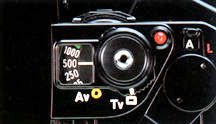 |
It is a mode for commanding movement.Shutter-priority
is best for action shots because it allows a photographer, to choose the shutter
speed to determine a fast setting to freeze or a slow speed to portray a sense of
movement by creating artistic blur effects - on purpose. Once you have set the AE
Mode Selector on Tv, the shutter speed of your choice is easily set by the
AT Dial. The camera's electronic circuitry then takes over (Note the constant shutter
speed of '500' on the illustrated LED panel above, only the aperture values changes).
Information such as selected shutter speed, lighting conditions, film speed and maximum
aperture of the lens in use are processed and the proper aperture needed for correct
exposure is determined. All that's left for you to do is compose the picture, focus
and shoot.
Aperture-Priority AE - You set an aperture; the
camera chooses shutter speed to match your value selected for correct exposure of
an average scene. It is also
called the "mode of depth of field".
 |
|
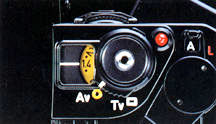 Note when the Mode Selector is set to AV i.e. "O" position, the aperture value will also be display under yellow scheme to differenciate from shutter speed scales. |
Generally, a smaller aperture gives a deeper depth of field, while that is exactly opposite when you are using a large aperture to throw distracting background out of focus. You can use two ways in the Canon A-1 to determine right quantum of depth of field for a particular scene. One is the traditional depth-of-field scale engraved on the lens, which gives you a numerical range within which the subject will be in focus. The other is by setting the lens' aperture ring to your selected aperture and pushing in the stop-down lever. You can then visually confirm the depth of field by looking in the viewfinder. (The viewfinder will dim when you activate the stopped down lever, but you can see a distinguishable difference when you use aperture value OTHER THAN the maximum aperture value of the lens in use. Setting the camera for aperture priority is easy by turning the AE Mode Selector to "Av" and using the AT Dial. And of course, the A-l's circuitry ensures perfect exposure, just as with shutter-speed priority.
Programmed AE - The camera sets both shutter
speed and aperture size for you. If you allow an inexperienced person to use your
A-1, set it for Programmed AE and good exposures should result.
 |
|
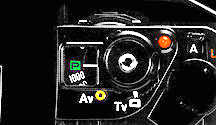 Just set the lens to the 'A' (auto), the mode selector to Tv and rotate the shutter speed scale to "P" position above the '1000' shutter speed. |
The A-1 has something for everyone,
the novice included - that is why as I have said earlier, the Canon A-1 can be a
very simple-to-use SLR camera. Programmed AE is a mode that, though especially useful
for beginners, can also be of value to the professional in certain situation where
responsiveness is required. Once you have flicked the AE Mode Selector on Tv
and set the AT Dial on "P", exposure is completely left up to the
camera. While it's great for beginners because it eliminates any possibility of exposure
error and even for a working professional that can help him free to concentrate on
subject and composition. And it's convenient for both for capturing those spur-of-the-moment
shots. This mode is called programmed AE because correct exposure is decided according
to the subject's brightness and a programmed set of aperture/shutter-speed combinations.
As the light gets dimmer this combination changes accordingly until it reaches its
lowest safe combination of f/1.4 and 1/8 sec. (if the lens' maximum aperture is f/1.4
with ISO 100 film). In conditions is darker than this, only the shutter speed will
change to lower settings, in effect turning this mode into aperture priority. The
fact that programmed AE is possible for exposure values as low as EV-2 makes this
mode even more useful. This mode is a Canon innovation and the A-1 was the first
ever camera to utilise it. Other subsequent Canon bodies that have incorporated this
mode were the AE-1 Program, T50, T70 and the T90. All the autofocus EOS models have
this mode as part of their list of features.
Stopped-down AE - When using non-meter-coupled
accessories between lens and camera, or an older FL lens, or an FD lens not set to
A, you control lens aperture manually.
 |
|
 No matter where the AE Mode Selector is set, the camera will determine the shutter speed necessary for correct exposure. |
Electronic Flash AE - Using the Canon "dedicated"
flash units, the camera is automatically set to the correct shutter speed and aperture
size when the flash ready-light goes on.
Just refer
to the calculator dial on the back of the flash unit and stay within the automatic
operating distance range.
 |
|
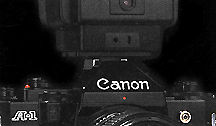 |
The AE-1 in 1976 has simplified flash photography with SLR cameras. Until the arrival of automatic flash, trying to decide how much illumination would be best for the subject was often a manual process, a time consuming job, often requiring calculations using a guide number. The AE-1 and the Canon A-1 have helped to popularised automatic flash. Canon has developed seven special automatic flash units for the A series, the Canon Speedlites 199A, 188A, 177A, 155A, 133A, 577G and 533G etc (With the exception of the T90, all of Canon's A-series and T-series will automatically set their X-sync with any A-series, T-series (except 300TL designed exclusively for the T-90) and G-series (533G & 577G) of Canon Speedlites), which will make AE flash photography possible with the A-1. Mount any of these onto the camera's hot shoe, turn it on, set the aperture on the flash, focus and shoot. With any of the Canon dedicated flash units mounted on, the A-1will automatically synchronizes the shutter speed to the maxium permissible sync speed of 1/60 sec. (unless shutter speed is set on "B") and its micro-computer controls the light output.
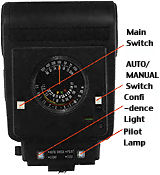 |
All this is done no matter whether the AE Mode Selector is set at Av or Tv. In addition to all this automation, the dedicated Speedlite 199A especially offers a number of personal control features. |
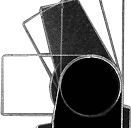 |
For depth-of-field control, there are three auto working apertures to choose from (f/2.8, f/5.6 and f/l l with ASA 100 film). Also, shutter speeds slower than 1/60 sec. can be selected in case you want more ambience light in the background. The 199A also allows bounce flash and flash coverage of 24mm lens field with the wide angle adapter.
Manual Control Exposure - Exposure control is not automatic. You set shutter speed and lens aperture manually. The camera exposure measuring system continues to work but it doesn't set any controls. Note the lens is set away from the 'A' (Auto) setting to any user defined aperture value on the aperture ring.
|
|
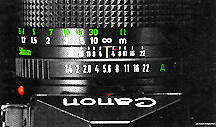 |
The five AE modes in the A-1 should be able to cover practically any photographic situation a photographer may encounter. But perhaps there are some photographers who still like the good old manual way or come across unusual lighting conditions that might constantly affecting meter reading. In this mode, the camera display shows the shutter speed you have selected and the aperture size the camera exposure meter recommends for an average scene. You can set aperture to the recommended value, or not, as you choose. You may prefer this mode when you want to use an exposure different than the camera meter suggests - perhaps because you are shooting a non-average scene or you wish to produce a special effect by over- or under-exposing a particular scene.
 |
In operation, all you have to do to obtain manual control is disengage the lens aperture ring from the "A" mark. Use this ring to set the aperture. The aperture the camera would normally have selected appears in the viewfinder after you have selected a shutter speed using the AT Dial with, of course, the AE Mode Selector on Tv. You can get proper exposure with this aperture, or rely on your own experience |
With FL lens or FD lens with non-meter coupled accessories: This mode is still possible but the exposure readout may be un-readable. In this case, the correct way is highly recommended to set the camera for Stopped Down AE mode instead.
| Previous | Next | 3/8
|
Back | Index
Page of Canon A-1
| Back |
Main Index
Page of Canon SLR Models
History
& Background
| Basic
Camera Operation
(14 Parts)
Main Reference
Map - HTML | PDF (270k)
Specification
- HTML | PDF (96k)
Shared Resources:
Winder A, Winder A2, Focusing Screens, Motor Drive MA, Databack A,
Speedlites & Macro photography.
Canon FD
Resources
A Series:
AE-1
| AT-1
| A-1 | AV-1
| AE-1 Program | AL-1
T- Series: T50
| T60
| T70
| T80
| T90
F-1
| New F-1
Canon FL
Resources
Pellix
| FTQL
FL | Canon FDn lenses. | Early versions of FD lenses
Highly suggestive useful external links/resources created by Mr.Christian Rollinger:
Essentials: - Canon A1 Repair/Service Guide | Determine Years of Made of your
Canon
Canon Flash models:- Canon 300TL flash(1.5MB); Macrolite ML-1(HTML); Macrolite ML-2;
Macrolite ML-3; Speedlite 133a; Speedlite 155a(HTML); Speedlite 177a; Speedlite 188a(HTML); Speedlite 199a; Speedlite 244t; Speedlite 277t (HTML); Speedlite
533; Speedlite 577
Others:- Canon Auto Bellow Unit Manual; Canon Macro Photography Guide, Canon Slide Duplicator Manual, Canon Angle Finder User's Manual
| Message Board |
for your Canon
A-Series SLR camera(s)
| Message Board | for your Canon optics
in a shared environment
| Message Board | Specifically for Dispose or Looking for Canon Photographic
Equipment
Home - Photography in Malaysia
![]()
Copyright
© 2000.
leofoo ®. MIR Web Development Team.
Maintenance
Team: Kaipin, Terry Carraway & Dr Strangelove; Pawel Nabe for his image
on the Data Memory Back. EEwyn Foo, my nephew, who
has spent quite a number of nights converting the original manual in HTML format.
Mr. Richard Yeow, General Manager
-Optical Division of Canon Marketing for granting special
permission to reproduce this manual into HTML format in his site as a form of obligation
to all Canon FD mount users worldwide.
* Canon, FD Lenses, Canon Marketing are registered
trade names or trademarks of Canon
Inc. Japan.